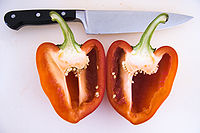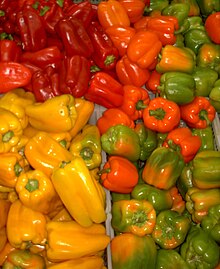Bell pepper: Difference between revisions
Monotonehell (talk | contribs) RV V |
Added {verify} template -- no references are given |
||
| Line 1: | Line 1: | ||
{{verify}} |
|||
[[Image:Bell pepper cut apart.jpg|left|thumb|200 px|Bell pepper cut apart.]] |
[[Image:Bell pepper cut apart.jpg|left|thumb|200 px|Bell pepper cut apart.]] |
||
{{Taxobox |
{{Taxobox |
||
Revision as of 19:19, 4 October 2006
This article needs additional citations for verification. |

| Bell pepper | |
|---|---|

| |
| A variety of colored bell peppers | |
| File:Greenpeppers.jpg | |
| Green peppers | |
| Scientific classification | |
| Kingdom: | |
| Division: | |
| Class: | |
| Subclass: | |
| Order: | |
| Family: | |
| Genus: | |
| Species: | C. annuum
|
| Binomial name | |
| Capsicum annuum | |
| Bell pepper | |
|---|---|
| Heat | Mild (SR: 0) |
- For green peppercorns, see Black pepper.
Bell pepper is a Cultivar Group of the species Capsicum annuum, as are the jalapeño and pimento. The bell pepper refers to the actual fruit of the capsicum plant. Outside of the United States bell peppers are commonly called paprika in areas such as Scandinavia, Hungary and Indonesia; Piman in Japan; capsicum in India, Malaysia and Australia; and mangoes[1] (or mangos) in parts of the US around southern Ohio, Indiana, and northern Kentucky (and should not be confused with the tropical fruit known properly as a mango). In Russia it is commonly called болгарский перец (bolgarskiy perets), meaning Bulgarian pepper. In France, it is called poivron, with the same root as poivre (meaning black pepper). Bell peppers contain a recessive gene that eliminates the capsaicin in the fruit.
The color can be green, red, yellow, orange and, more rarely, white, purple and brown depending on when they are harvested. Green peppers are unripe bell peppers, while the others are all ripe, with the color variation due to cultivar selection. Because they are unripe, green peppers are less sweet and slightly more bitter than yellow, orange, or red peppers, which all taste similar. The taste of ripe peppers can also vary with growing conditions and post-harvest storage treatment; the sweetest are fruit allowed to ripen fully on the plant in full sunshine, while fruit harvested green and after-ripened in storage are less sweet. Peppers were grown in Central and South America in pre-Columbian times. Pepper seeds were later carried to Spain in 1493 and from there spread to other European and Asian countries.
Per 100g, has about 140mg of Vitamin C.
Nutritional value
| Nutritional value per 100 g (3.5 oz) | |
|---|---|
| Energy | 111 kJ (27 kcal) |
6 g | |
| Sugars | 4 g |
| Dietary fiber | 2 g |
0.3 g | |
1 g | |
| Vitamins | Quantity %DV† |
| Vitamin C | 211% 190 mg |
| Other constituents | Quantity |
| Water | 92 g |
| †Percentages estimated using US recommendations for adults,[1] except for potassium, which is estimated based on expert recommendation from the National Academies.[2] | |
See also: List of chili pepper cultivars
- ^ United States Food and Drug Administration (2024). "Daily Value on the Nutrition and Supplement Facts Labels". FDA. Archived from the original on 2024-03-27. Retrieved 2024-03-28.
- ^ National Academies of Sciences, Engineering, and Medicine; Health and Medicine Division; Food and Nutrition Board; Committee to Review the Dietary Reference Intakes for Sodium and Potassium (2019). Oria, Maria; Harrison, Meghan; Stallings, Virginia A. (eds.). Dietary Reference Intakes for Sodium and Potassium. The National Academies Collection: Reports funded by National Institutes of Health. Washington, DC: National Academies Press (US). ISBN 978-0-309-48834-1. PMID 30844154. Archived from the original on 2024-05-09. Retrieved 2024-06-21.
